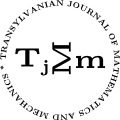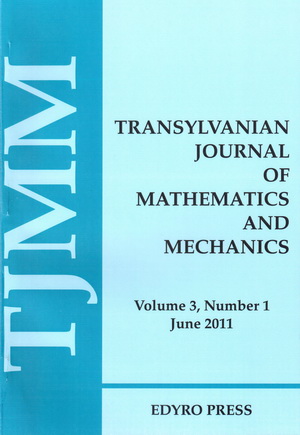Volume 12 (2020), Number 1
Some New Simpson-Like Type Inequalities Via Preqausiinvexity
Author(s): T. CHIHEB, N. BOUMAZZA and B. MEFTAH
Abstract: In this paper, we first establish a new integral identity which represent a partielle result, by using this identity we derive some new Simpson like type integral inequalities for functions whose second derivatives are prequasiinvex functions. we also discuss some special cases where the second derivatives are monotonous functions. At the end we give some applications to special means.
DownloadAn Application of the Admissibility Types in -Metric Spaces
Author(s): MARIA DOBRIȚOIU
Abstract: In this paper we present a fixed point theorem for the solution of the nonlinear Fredholm integral equation as an application of a result of S. Radenović et al., in [14]. In order to obtain this existence result, we used also, the notions of admissibility types defined on a -metric space, in [17].
DownloadModified -Metric Spaces and Some Fixed Point Results
Author(s): ABDULLAH KARAMI, SHABAN SEDGHI, NABI SHOBE and ZORAN D. MITROVIĆ
Abstract: In this paper, a structure of modified -metric spaces is introduced which can be viewed a generalization of both -metric and -metric spaces. Also, the notions of -contractive mappings in the modified -metric spaces is given. We also investigate the existence of fixed point for such mappings under various contractive conditions. We provide example and an application to illustrate the results presented herein.
DownloadChebyshev Type Inequalities Involving Generalized Proportional Fractional Integral Operators
Author(s): İLKER MUMCU, ERHAN SET and ARTION KASHURI
Abstract: A number of definition of fractional integral operators have, recently, been presented. In [11], Jarad et al. introduced the proportional generalized fractional integrals. In this paper, we motivated essentially by the earlier works and established some Chebyshev type inequalities for synchronous functions involving generalized proportional fractional integral operators. Also we have results containing confluent hypergeometric functions and incomplete gamma functions.
DownloadA Problem With Second Kind’s Nonlocal Condition for Pseudohyperbolic Equation
Author(s): AICHA SAKHRI and AHCENE MERAD
Abstract: In this article, the Faeod-Galerkin method is proposed for solving a pseudohyperbolic type equation with an integral condition. We construct a discrete numerical solution of the approximate problem.
DownloadThree-Dimensional Influence Functions and Integration Formulas for Many Boundary Value Problems Within a Thermoelastic Half-Layer
Author(s): VICTOR ȘEREMET and ION CREȚU
Abstract: The aim of this paper is the constructing of the main thermoelastic displacements Green’s functions (MTDGFs) for a generalized 3D BVP of uncoupled thermoelasticity for a half-layer. To reach this aim are derived structural formulas for MTDGFs expressed via respective Green’s functions for Poisson’s equation (GFPE) by using harmonic integral representations method (HIRM). These structural formulas are validated by the checking the equations of thermoelasticity with respect to point of application the heat source and the nonhomogeneous Poisson’s equation with respect to point of response in which the thermoelastic displacements appeared. In addition, they satisfy boundary conditions for temperature Green’s function with respect to point application the displacements and to mechanical boundary conditions with respect to point of application the heat source. The thermoelastic volume dilatation (TVD) derived separately from respective integral representations have to be equal to the TVD derived by using structural formulas for MTDGFs. The final analytical expressions for MTDGFs obtained on the base of mentioned above structural formulas for eight new 3D BVPs of thermoelasticity within half-layer contain Bessel functions of the zero-order and of the second type. Finally, the integration formulas for thermal displacements and stresses, created by inner heat source and by the thermal data given of the surface of the half-layer are presented also.
DownloadThe Direct Problem and the Inverse Problem of the Normal Distribution. Mathematical Models-Algorithms-Program
Author(s): CONSTANTIN ZĂVOIANU and FELICIA ZĂVOIANU
Abstract: In this article we present two mathematical models, the algorithms that implement them, and the software that solves the direct problem and the inverse problem of the normal distribution. Tandem solving of the two issues provides both the possibility of forming an overview of the normal distribution as well as a set of useful and strictly necessary information to perform an informative analysis of the effectiveness of the used mathematical models and algorithms. The efficiency of mathematical models and, implicitly, of their algorithms is ultimately expressed through the accuracy and precision of the results obtained by using the software encoding these algorithms. The accuracy of the results reflects the extent to which the calculated value approaches the real value and the precision of the results refers to the exact number of digits in the representation of a double-precision mobile floating-point solution. Here, we have also demonstrated, using the concepts of absolute error and relative error, that the scientific approach in this article is rigorously substantiated both from a mathematical point of view and from the point of view of implementing algorithms in a high-level programming language.
Download

